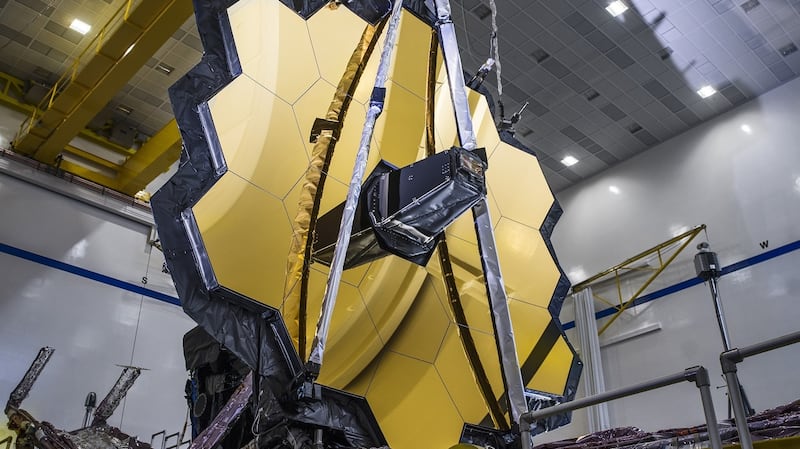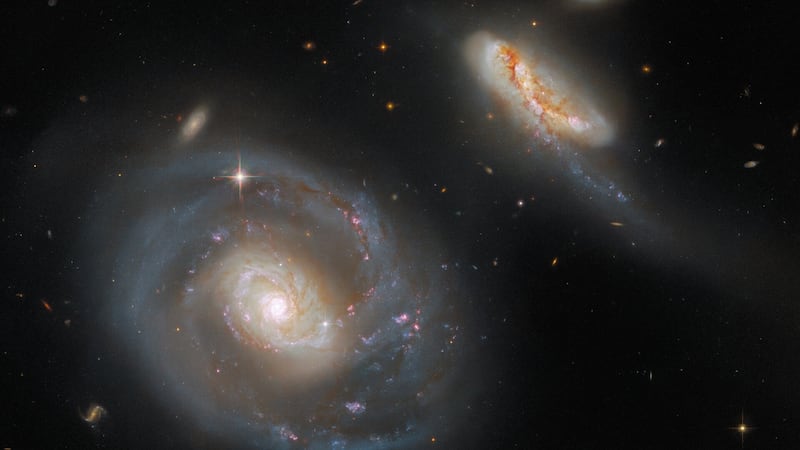On December 25th last the James Webb Space Telescope – JWST for short – was finally propelled into the heavens on an Ariane 5 rocket from French Guiana.
The telescope is the successor to Hubble, which has been capturing images of your favourite spiral galaxies and exploding supernovas, from space, since 1990.
The JWST team successfully fully deployed its iconic 6.4m, gold-coated primary mirror on January 8th, completing the final stage of all major spacecraft deployments to prepare for science operations. The successful unfolding of the telescope was a complex but impressive engineering masterpiece in itself.
In development since the mid-1990s, it is now set to light up our minds with images of galaxies and stars not yet seen, becoming Nasa’s flagship astrophysics mission.
The telescope is currently undergoing testing and recent results from its mirror alignment process produced its first image. But the real work is set to begin in early summer when the first images captured by its infrared instruments are expected.
The infrared capabilities which the JWST boasts are a technological first – as of yet unachieved by any telescope – and require heat protection with the implementation of a unique sunshield, one of the telescopes most intriguing aesthetics.
Dr Patrick Kavanagh is a researcher at the Dublin Institute of Advanced Studies who is working on a key infrared sensor for the telescope.
The JWST has been designed to focus primarily on infrared frequencies. Why is that?
The JWST has been designed to answer some of the biggest questions in astronomy, primarily those related to the early universe. In order to do that it has been optimised for the infrared part of the electromagnetic spectrum – it is a next-generation infrared telescope – which will allow us peer back in time to the earliest parts of the universe, that is, to the first stars and galaxies.
With its relatively small 2.4-metre diameter mirror, Hubble wasn’t able to do that. So the JWST has been designed with a much larger 6.5-metre mirror, for higher resolution, and with special infrared detectors which will allow us look at the first galaxies and the development of galaxies over cosmic time.
It will also allow us study how stars form, hopefully shedding some light on some of the many unanswered questions about the early stages of star formation. Specifically, its infrared capabilities will allow us see see through the clouds of dust around the forming stars.

Why does it have such a huge sunshield?
Okay, so the telescope is designed to see infrared, but infrared is really just heat. So, imagine if your telescope and your detectors are warm, because of sunlight.
This will interfere with the signals you actually want to see, meaning there will be what we call noise. We are trying to detect these really faint infrared signals from the depths of space, so we need to reduce that noise, and the way it’s done is by using this giant sunshield, essentially cooling the detector.
We do this by orienting the spacecraft in such a way that the sunshield faces the sun. This takes care of what we call near-infrared signals. But we also want to look at mid-infrared frequencies.
For those we actually need some additional cooling – the sunshield won’t be enough – so we use cryo-cooling, which is basically an electronic cooling system, essentially a fridge, to cool it down even further.
What do you work on specifically?
I’ve worked on the calibration pipeline for the mid-infrared instrument, known as MIRI, at the moment. Let me explain. There’s no such thing as a perfect detector, you see.
The detector itself, when in space, will introduce some artefacts into your image. So, the test team, which I am part of, tries to understand and characterise these effects so that they can be removed. This is basically a series of correction steps.
The telescope and its sensors are tested for years in advance of it being sent up into space. Components are tested in cryo-vac chambers, using light sources, which replicate the conditions in space, that is, in a cold vacuum with some sunlight.
When MIRI was sent over to us for integration into the science module it underwent tests before being attached to the telescope itself. Then it went through the same process again. That’s what we do. We test it under conditions which replicate its future environment in space as best we can.

What will the JWST tell us about exoplanets?
The JWST will primarily aim to characterise the atmospheres of exoplanets. Using the so-called transit method, where the level of starlight observed dips when an exoplanet passes its host star, we can analyse the light in terms of how much is effectively reflected or observed by the exoplanet, essentially determining its atmospheric make-up.
This will complement the existing exoplanet telescopes, like Kepler, which has already completed its mission, and detected over 2,000 planets. Many of the existing exoplanet telescopes are really planet finders, meaning they seek out, find and survey new planets.
The JWST, on the other hand, will look at planets which are already known, taking the best candidates from the surveys, pointing at them and using its sophisticated instruments to observe and analyse their atmospheres.
In principle, the JWST should also be able to look for seasonal variations in planetary atmospheres and other atmospheric phenomena, like clouds, based on changes in some of the reflective properties of the light.
What surprises do you think the James Webb could yield?
It is absolutely impossible to predict that. Exactly zero chance. And that’s the wonder of nature and of science.
Generally speaking we will gain some improved understanding in various fields. We will be able to use the observations to test various theories, for example.
The telescope was designed to answer some specific questions in astrophysics – the project has some defined goals – but that doesn’t mean it won’t answer some other questions we hadn’t considered.
It will likely even throw up even more questions, around new phenomena, which we will then have to ponder. You just can’t predict what it will reveal, and that is very exciting.
Dr Conor Purcell writes about science, society and culture. He can be found on twitter @ConorPPurcell – some of his articles at cppurcell.tumblr.com










